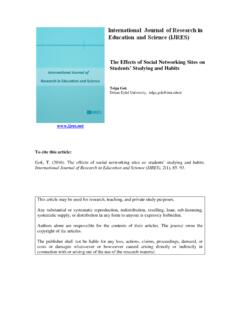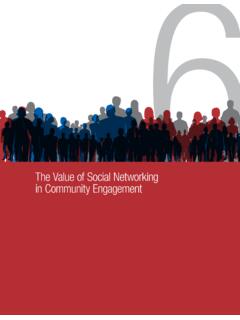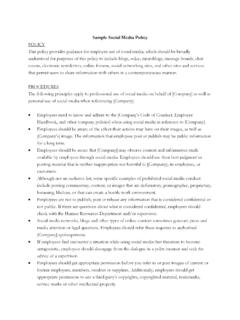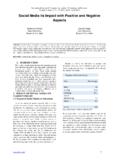Transcription of Use of Social Media and its Impact on Academic Performance ...
1 Journal of Education and Practice ISSN 2222-1735 (Paper) ISSN 2222-288X (Online) , , 2015 94 Use of Social Media and its Impact on Academic Performance of Tertiary Institution Students: A Study of Students of Koforidua Polytechnic, Ghana M. Owusu-Acheaw1 Agatha Gifty Larson2 1. Koforidua Polytechnic, Koforidua, Ghana 2. University of Education, Winneba, Ghana Abstract The study sought to assess students use of Social Media and its effect on Academic Performance of tertiary institutions students in Ghana with a focus on Koforidua Polytechnic students. Questionnaire was used for collecting data. Out of one thousand five hundred and seventy-eight copies of the questionnaire distributed, one thousand five hundred and eight were retrieved which represented a response rate of %.
2 The study revealed that majority of the respondents had mobile phones which also had Internet facility on them and had knowledge of the existence of many Media sites. The study further confirmed that most of the respondents visit their Social Media sites using their phones and spend between thirty minutes to three hours per day. In addition the study revealed that the use of Social Media sites had affected Academic Performance of the respondents negatively and that there was direct relationship between the use of Social Media sites and Academic Performance . The study recommends among others that, students with mobile phones having internet facility should be encouraged to use it to supplement their research in the library rather than the usual charting with friends all the time. Students should be encouraged to limit the time they spend on their Social Media sites per day and advise them to rather substitute those hours to read novels to improve their knowledge.
3 Since the use of Social Media sites had affected the Academic work of students negatively there is the urgent need for the introduction of students to the availability of novels and other information resources or materials that can help them academically. Keywords: Social Networks, Academic Output, Tertiary Students, Internet Use, Ghana 1. Introduction Social Media has exploded as a category of online discourse where people create content, share it, bookmark it and network at a prodigious rate. Because of its ease of use, speed and reach, Social Media is fast changing the public discourse in society and setting trends and agenda in topics that range from the environment and politics to technology and the entertainment industry(Asur and Huberman, 2010). In the last ten years, the online world has changed dramatically, thanks to the invention of Social Media , young men and women now exchange ideas, feelings, personal information, pictures and videos at a truly astonishing rate.
4 Seventy-three percent of wired American teens now use Social Media websites (Oberst, 2010). Martn, (2008) & Lusk, (2010) share the same concept of Social Media . To them Social Media is the use of Facebook, Blogs, Twitter, My Space and LinkedIn for the purpose of communication, sharing photos as well as videos. However for the purpose of this study Social Media is captured within the use of internet through Facebook, Whatsap, Twitter, Skype, MySpace as well as Yahoo Messenger for communication sharing of ideas, sharing of photos and videos by users. The increased use of Social networking Websites has become an international phenomenon in the past several years. What started out as a hobby for some computer literate people has become a Social norm and way of life for people from all over the world (Boyd.)
5 2007). Teenagers and young adults have especially embraced these sites as a way to connect with their peers, share information, reinvent their personalities, and showcase their Social lives (Boyd, 2007). In the past years, Social Media websites have become common; giving young people a new way to interact with each other and communicate with the world. Social networking became popular between 2004 and 2006, after Facebook and MySpace were created. Facebook, for example has over 500 million members and it is still growing and approximately 85% of undergraduate students are Facebook users (Schneider, 2009). These numbers are expected to grow since Facebook users will continue to grow. And this is not only true for Facebook, numbers for YouTube users closely follow as well (University of New Hampshire, 2009).
6 Social networking websites provide tools by which people can communicate, share information, and create new relationships. With the popularity of Social networking websites on the rise, our Social interaction is affected in multiple ways as we adapt to our increasingly technological world. The way web users interact and talk to each other has changed and continues to change. These users now socialize through the internet and it takes away from the person socialization that has been around forever. Social networking websites have affected our Social interaction by changing the way we interact face-to-face, how we receive information, and the dynamics of our Social groups and friendships (Asur and Huberman, 2010). Journal of Education and Practice ISSN 2222-1735 (Paper) ISSN 2222-288X (Online) , , 2015 95 Communicating through the internet and Social networking websites is quite different from communicating in- person- to- person situation.
7 When users communicate through these websites, they use things like instant message (IM) and chatting as well as status or Twitter updates to talk to friends and express themselves (Kaitlin, 2010). Kaitlin (2010) further opines that Social networking websites also affect the way we receive information and news. The sites open up different portals through which we get information and create more diverse news outlets. Most of the studies, Choney (2010), San Miguel, (2009) Enriquez (2010), Karpinski & Duberstein (2009), Khan, (2009), Kubey et al (2010), conducted on students use of the Social Media sites and its Impact on Academic Performance focused on students in the developed world. It is against this background that it has become necessary to conduct this research aimed at investigating students use of Social Media sites and their Impact on Academic Performance among Polytechnic students in Ghana.
8 This is largely because; no empirical study has been conducted in Ghana to find out the Impact of students use of Social Media sites on Academic Performance of Polytechnic students in Ghana. Statement of problem The rapid advancement of Media technology has had a great Impact on the way people communicate on a daily basis. The growing dimension of the use of the Social Media among the youth of today cannot be over emphasized. Over the years, Social networking among students has become more and more popular. It is a way to make connections, not only on campus but with friends outside of school. Social networking is a way that helps people feel they belong to a community. Due to the increased popularly of it, economists and professors are questioning whether grades of students will not be affected by how much time is spent on these sites.
9 Choney, (2010), MehMood & Taswir, (2013), Kist (2008), Jacobsen & Forste, (2011), believe that the use of technology such as internet is one of the most important factors that can influence educational Performance of students positively or adversely. Many parents and guardians are worried that students are spending too much time on facebook and other Social Media sites and have not enough time to study. Though parents are worried about students constant use of the Social Media sites, many students continue to utilize these sites on a daily basis. It is against this background that this research is being conducted to ascertain the Impact of students use of Social Media sites on their Academic work. Objectives of the Study The general objective of the study was to find out the Impact of Social Media on Academic Performance among students.
10 The specific objectives of the study were as follows: i. To examine the Impact of Social Media on Academic Performance among the students. ii. To identify the benefits obtained from using the Social Media . iii. To ascertain what students use Social Media sites for Research Questions i. Does the use of Social Media sites have any Impact on student s Academic Performance ? ii. What are the benefits they derive from using Social Media ? iii. Why do student visit their Social Media sites? Hypothesis i. There is a relationship between time spent on Social Media and Academic Performance ii. There is relationship between the use of Social Media and excellent Academic Performance Literature Review According to Junco al et (2010), Social Media are a collection of internet websites, services, and practices that support collaboration, community building, participation, and sharing.














